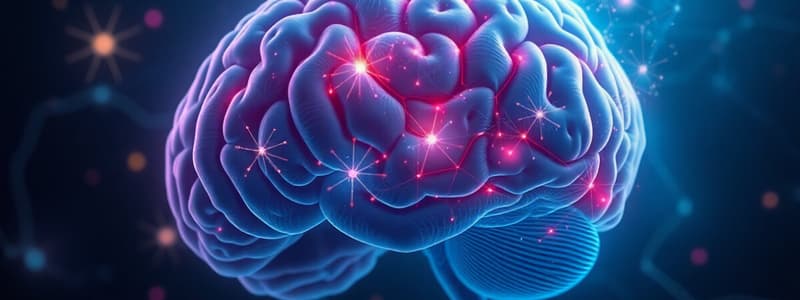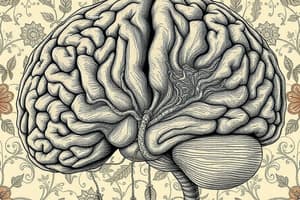Podcast
Questions and Answers
How do older and newer structures in the brain relate to each other?
How do older and newer structures in the brain relate to each other?
- Older structures are folded inside newer ones. (correct)
- They exist independently and do not interact.
- Newer structures replace older ones over time.
- Newer structures are folded inside older ones.
What is the cerebral cortex also known as?
What is the cerebral cortex also known as?
- Hippocampus
- Cerebellum
- Amygdala
- Neocortex (correct)
Which lobe of the brain is most associated with planning and decision-making?
Which lobe of the brain is most associated with planning and decision-making?
- Temporal Lobe
- Parietal Lobe
- Frontal Lobe (correct)
- Occipital Lobe
If someone struggles with spatial reasoning and coordinating movements, which area of the brain is most likely affected?
If someone struggles with spatial reasoning and coordinating movements, which area of the brain is most likely affected?
What primary function is the occipital lobe responsible for?
What primary function is the occipital lobe responsible for?
Which of the following is the main function associated with the temporal lobe?
Which of the following is the main function associated with the temporal lobe?
Which part of the brain is responsible for maintaining homeostasis by regulating thirst, hunger, and temperature?
Which part of the brain is responsible for maintaining homeostasis by regulating thirst, hunger, and temperature?
What would be the most likely result of damage to the ventromedial hypothalamus?
What would be the most likely result of damage to the ventromedial hypothalamus?
What is the general function of the brain stem?
What is the general function of the brain stem?
Which of the following is the primary function of the limbic system?
Which of the following is the primary function of the limbic system?
What is the role of the corpus callosum in the brain?
What is the role of the corpus callosum in the brain?
What is the role of the somatosensory cortex?
What is the role of the somatosensory cortex?
A person has difficulty understanding the emotional context of memories. Which specific brain structure is most likely involved?
A person has difficulty understanding the emotional context of memories. Which specific brain structure is most likely involved?
Considering the case study of Phineas Gage, what was the primary result of the damage to his frontal lobe and limbic system?
Considering the case study of Phineas Gage, what was the primary result of the damage to his frontal lobe and limbic system?
In split-brain patients where the corpus callosum is severed, what is one notable outcome regarding hemispheric communication?
In split-brain patients where the corpus callosum is severed, what is one notable outcome regarding hemispheric communication?
Flashcards
Cerebral Cortex
Cerebral Cortex
The outer layer of the brain, divided into two hemispheres and four lobes; also known as the neocortex or cerebrum.
Executive Command Center
Executive Command Center
Located in the frontal lobe; responsible for planning, organizing, prioritizing, managing emotions, personality, integrating thought, and assessing risk.
Center for 'Body Sensations'
Center for 'Body Sensations'
Located in the parietal lobe; responsible for processing body sensations such as touch, pain, heat, and cold, and kinesthetics, which is awareness of body parts in motion.
Somatosensory Cortex
Somatosensory Cortex
Signup and view all the flashcards
Center for Vision
Center for Vision
Signup and view all the flashcards
Temporal Lobe
Temporal Lobe
Signup and view all the flashcards
Limbic System
Limbic System
Signup and view all the flashcards
Lateral vs Ventromedial Hypothalamus
Lateral vs Ventromedial Hypothalamus
Signup and view all the flashcards
Cerebellum
Cerebellum
Signup and view all the flashcards
Corpus Callosum
Corpus Callosum
Signup and view all the flashcards
Split Brain
Split Brain
Signup and view all the flashcards
Motor Cortex
Motor Cortex
Signup and view all the flashcards
Brain Structure Organization
Brain Structure Organization
Signup and view all the flashcards
Hypothalamus
Hypothalamus
Signup and view all the flashcards
Study Notes
- The brain has multiple structures and subsystems that communicate to produce seamless experiences.
- Older brain structures are folded inside newer ones.
- The brain's organization starts with the outer shell (cortex) and moves inside to older structures.
Brain Overview
- See https://www.youtube.com/watch?v=0-8PvNOdByc for an overview of brain structures.
Cerebral Cortex
- The Cerebral Cortex, also known as the "neocortex" or "cerebrum", is divided into 2 hemispheres and 4 lobes.
Frontal Lobe
- The frontal lobe is the executive command center for planning, organizing, and prioritizing.
- Keeps emotions in check while also responsible for personality.
- The frontal lobe integrates thought, assesses risk, and controls the motor area for moving body parts.
Parietal Lobe
- The parietal lobe is the center for "Body Sensations".
- It governs kinesthetics, which is knowledge of body parts in motion.
- The parietal lobe integrates somatosensory information like pain, touch, heat, and cold.
- Is very developed in the blind, potentially compensating for the lack of visual input.
Somatosensory Cortex
- The somatosensory cortex processes body sensations, including touch, pain, cold, pressure, texture, roughness, and smoothness.
Motor and Sensory Maps
- The motor and sensory maps refers to structural organization of the the brain between the motor cortex (precentral gyrus) and somatic sensory cortex (postcentral gyrus).
Occipital Lobe
- The occipital lobe functions as the center for vision and contains the primary visual cortex and feature detector cells
- Approximately 40% of the brain handles vision.
Temporal Lobe
- The temporal lobe is responsible for speech, language, hearing (primary auditory cortex), and auditory memory.
Limbic System
- The limbic system is the older part of the brain responsible for emotions, memories, and motivators.
- Key structures include the hypothalamus, pituitary gland, amygdala, and hippocampus.
- The hypothalamus maintains homeostasis by regulating thirst, hunger, temperature, and sexual behavior, and regulates hormones.
- The hippocampus is a key memory area and is often the first to be affected in Alzheimer's disease.
- The amygdala is a powerful emotional area of the brain that deals with fear, anger, and aggression.
Appetite
- Appetite mechanisms within the brain include the lateral hypothalamus, which stimulates hunger.
- The ventromedial hypothalamus contributes to satiety of feeling full.
Brain Stem
- The brain stem, also known as the "old brain", includes medulla and reticular formation structures.
- The medulla controls vital functions such as heartbeat, breathing, and reflexes like swallowing, sneezing, and coughing.
- The reticular formation regulates arousal and alertness.
Cerebellum
- The cerebellum, or "little brain", coordinates movement, procedural memory, and spatial mapping.
Brain and Behavior Relationships
- Phineas Gage was a railroad worker in Vermont (1848) whose frontal lobe and limbic system connection was severed, leading to personality changes.
Brain Hemispheres
- The left brain functions include: right side of body control, number skills, math/scientific skills, written/spoken language, objectivity, analytical thought, logic and reasoning.
- The right brain functions include: left slide of body control, 3-D shapes, music/art awareness, intuition, creativity, imagination, subjectivity, synthesizing, emotion, and face recognition.
Corpus Callosum
- The corpus callosum is a large bundle of over 200 million myelinated nerve fibers that connect the two brain hemispheres, allowing communication between the right and left sides of the brain.
Studying Differing Brain Functions
- Input can be limited to one side of the brain to observe differing responses.
- Observing a natural experiment can be done with looking at people who have had connecting fibers in the corpus callosum severed; communication between hemispheres at higher levels isn't possible in these individuals..
Split Brained Patients
- Split brained patients refers to individuals who have had their corpus callosum severed.
- See https://www.youtube.com/watch?v=ZMLzP1VCANo for more information.
Studying That Suits You
Use AI to generate personalized quizzes and flashcards to suit your learning preferences.




